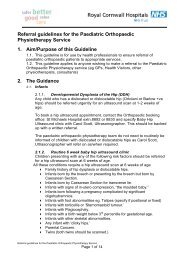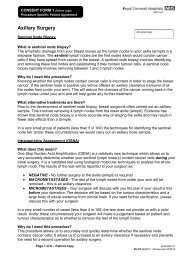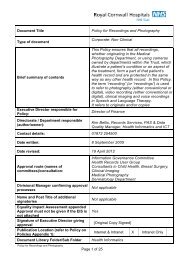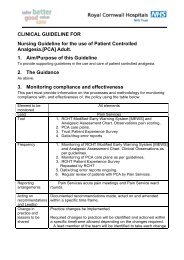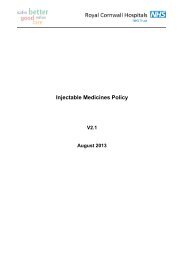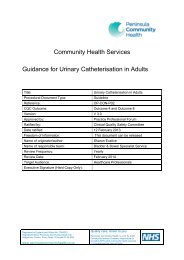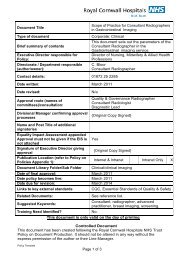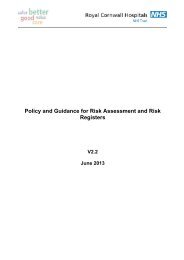Management of Extravasation of Cytotoxic Drugs in Children
Management of Extravasation of Cytotoxic Drugs in Children
Management of Extravasation of Cytotoxic Drugs in Children
Create successful ePaper yourself
Turn your PDF publications into a flip-book with our unique Google optimized e-Paper software.
8. Treatment <strong>of</strong> <strong>Extravasation</strong> from Central Venous<br />
Access Devices: PICC’s, Hickman L<strong>in</strong>es & Portacaths<br />
8.1 Although less likely to occur an extravasation occurr<strong>in</strong>g from an <strong>in</strong>dwell<strong>in</strong>g<br />
central l<strong>in</strong>e can be particularly problematic because <strong>of</strong> the depth <strong>of</strong> the l<strong>in</strong>e and<br />
the potential <strong>of</strong> slower development <strong>of</strong> signs and symptoms.<br />
8.2 <strong>Extravasation</strong> can either occur <strong>in</strong> the tunnelled section or <strong>in</strong> the deep section <strong>of</strong><br />
the implanted l<strong>in</strong>e:<br />
8.3 <strong>Extravasation</strong> can occur due to fracture <strong>of</strong> the catheter, perforation <strong>of</strong> the<br />
superior vena cava, formation <strong>of</strong> a fibr<strong>in</strong> sheath on catheter or <strong>in</strong>complete<br />
placement or dislodgement <strong>of</strong> the needle.<br />
8.4 Patients should be educated to the possibility <strong>of</strong> this happen<strong>in</strong>g and that burn<strong>in</strong>g<br />
or pa<strong>in</strong> on adm<strong>in</strong>istration is not normal and should be reported immediately.<br />
8.5 Follow steps as above, leav<strong>in</strong>g the central l<strong>in</strong>e <strong>in</strong> place. The l<strong>in</strong>e should be x-ray<br />
and removed as soon as cl<strong>in</strong>ically appropriate.<br />
8.6 Referral to plastic surgeon should be made<br />
Immediate Action<br />
1 Stop the adm<strong>in</strong>istration <strong>of</strong> the cytotoxic drug<br />
immediately, leav<strong>in</strong>g the central l<strong>in</strong>e <strong>in</strong> place.<br />
Rationale<br />
To prevent further <strong>in</strong>filtration.<br />
Prompt action to m<strong>in</strong>imise damage is important.<br />
2 Expla<strong>in</strong> what has been suspected <strong>of</strong> happen<strong>in</strong>g<br />
and next procedure to the<br />
patient/parent/guardian.<br />
To obta<strong>in</strong> patient’s and/or carer’s co-operation and<br />
consent.<br />
3 Attempt to aspirate as much drug as possible<br />
with a new syr<strong>in</strong>ge.<br />
To remove any residual drug.<br />
4 Mark the area with a pen and take digital pictures<br />
if possible<br />
To enable the size <strong>of</strong> the area to be evaluated and<br />
recalled at first presentation.<br />
5 Immediately refer to a senior member <strong>of</strong> medical<br />
staff<br />
The potential for damage is much greater than with<br />
a peripheral l<strong>in</strong>e.<br />
6 Refer to plastic surgeon For specialist <strong>in</strong>put<br />
7 Complete all documentation. Green Card<br />
(available <strong>in</strong> the extravasation kit), DATIX,<br />
medical and nurs<strong>in</strong>g notes<br />
Record all actions taken (see below)<br />
<strong>Management</strong> <strong>of</strong> <strong>Extravasation</strong> <strong>of</strong> <strong>Cytotoxic</strong> <strong>Drugs</strong> <strong>in</strong> <strong>Children</strong><br />
Ratified: Review: 12




